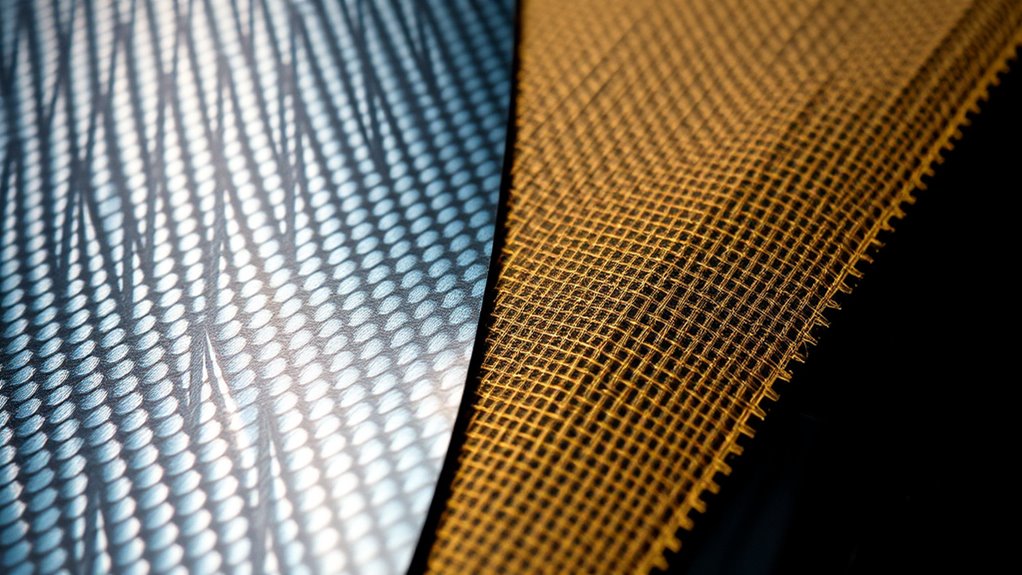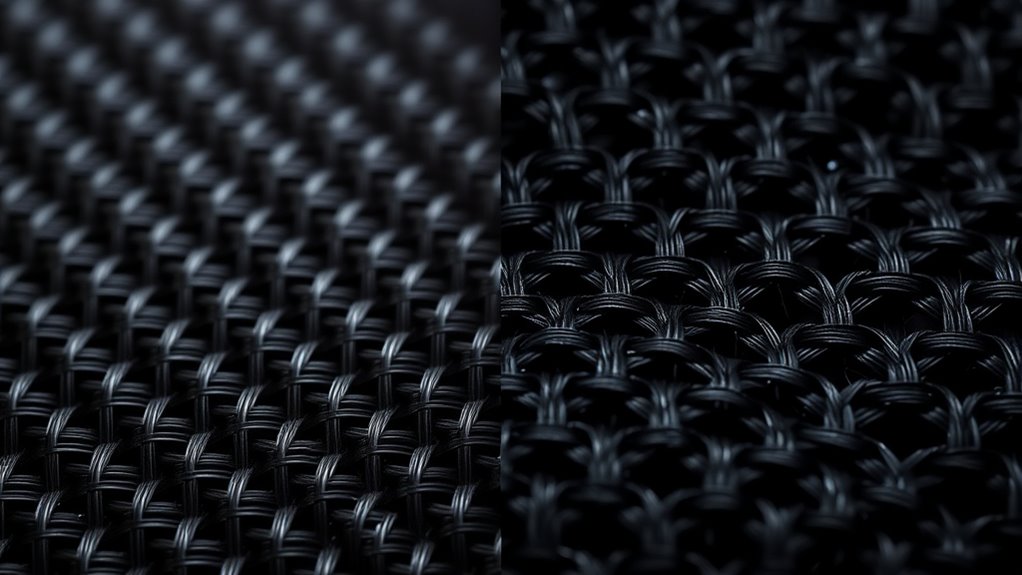When choosing between carbon fiber and Kevlar for strength, it depends on your needs. Carbon fiber offers outstanding stiffness, high strength-to-weight ratio, and durability under extreme forces, making it perfect for structural projects. Kevlar, on the other hand, excels in flexibility, tear resistance, and impact absorption, ideal for protective gear. Understanding these differences helps you pick the right fabric. Keep exploring to learn how each material’s unique strengths can elevate your applications.
Key Takeaways
- Carbon fiber offers superior structural strength and stiffness, ideal for load-bearing applications.
- Kevlar provides exceptional fiber durability with high resilience and impact resistance.
- Carbon fiber excels in rigidity but is more brittle, while Kevlar is flexible and absorbs shocks effectively.
- The choice depends on whether the application prioritizes stiffness (carbon fiber) or impact absorption (Kevlar).
- Both fabrics outperform others in their respective domains, making the best choice context-dependent.

When choosing the right fabric for your project, understanding its strength is vital. Fiber durability and material flexibility are two key factors that determine how well a fabric performs under stress. In the battle between carbon fiber and Kevlar, these qualities play a significant role in deciding which material is best suited for your needs. Both fabrics are known for their high-performance capabilities, but they excel in different areas, making it important to evaluate their strengths carefully.
Carbon fiber is celebrated for its exceptional fiber durability. Its tightly woven structure provides remarkable stiffness and strength-to-weight ratio, allowing it to withstand immense forces without breaking or deforming. This durability makes it ideal for applications where structural integrity is paramount, such as aerospace, automotive, or sporting equipment. However, this strength comes with a trade-off in material flexibility. Carbon fiber tends to be rigid and brittle, meaning it doesn’t bend easily without risking cracks or fractures. If your project demands a fabric that can absorb impacts or conform to complex shapes, carbon fiber might be limiting due to its inflexibility.
On the other hand, Kevlar offers impressive fiber durability with a different set of advantages. Known for its outstanding resistance to stretching and tearing, Kevlar’s fiber structure provides a high level of resilience against abrasion and ballistic impacts. Its flexibility is notably superior to carbon fiber, allowing it to bend and stretch without losing its protective qualities. This makes Kevlar a preferred choice for applications like body armor, protective clothing, and bicycle tires, where flexibility and impact absorption are critical. While Kevlar might not match carbon fiber’s stiffness or weight savings, its material flexibility grants it versatility and durability in dynamic environments.
When comparing these fabrics, consider the specific demands of your project. If you need a lightweight, rigid material that maintains shape under heavy loads, carbon fiber’s fiber durability and stiffness will serve you well. Conversely, if your project requires a fabric that can flex, absorb impacts, and resist tearing, Kevlar’s combination of fiber durability and material flexibility makes it the superior choice. Ultimately, it’s about matching each fabric’s strengths to your application’s unique requirements. Both materials possess incredible durability, but their differences in flexibility and stiffness define their best uses. Making the right choice involves balancing these qualities to guarantee your project achieves ideal strength and performance.
Frequently Asked Questions
How Does the Cost of Carbon Fiber Compare to Kevlar?
You wonder about the cost comparison between carbon fiber and Kevlar. Generally, carbon fiber has higher price differences, making it more expensive than Kevlar. The cost of carbon fiber can be twice or even three times that of Kevlar, mainly due to its manufacturing process and material quality. If budget is a concern, you might find Kevlar more affordable, but consider the strength and performance benefits when making your choice.
Which Fabric Is More Environmentally Sustainable?
You might be surprised to learn that Kevlar generally has a lower environmental impact than carbon fiber, mainly because it requires less energy to produce. While both fabrics face recyclability challenges, Kevlar’s manufacturing process is somewhat less resource-intensive. If sustainability matters to you, consider Kevlar, as it tends to be more environmentally friendly overall, thanks to its production and disposal considerations.
Can These Fabrics Be Recycled Effectively?
When considering recycling challenges, you realize that both carbon fiber and Kevlar pose significant hurdles due to their complex manufacturing processes. Recycling these fabrics effectively is difficult, which impacts their environmental footprint. Their durability makes them valuable, but their end-of-life disposal harms the environment if not managed properly. You understand that improving recycling methods could reduce their environmental impact, making these advanced materials more sustainable options in the future.
How Do Temperature Variations Affect Fabric Performance?
Temperature variations impact fabric performance by affecting their thermal stability and durability under heat. When exposed to high temperatures, some fabrics may weaken or deform, reducing their effectiveness and lifespan. You should consider how well a fabric maintains its properties across temperature swings. For instance, fabrics with high thermal stability resist heat damage, ensuring durability under heat. Conversely, those with poor thermal stability may compromise safety and longevity in fluctuating conditions.
Are There Specific Industries Preferring One Fabric Over the Other?
You’ll notice that industry applications and market preferences greatly influence fabric choices. For example, aerospace and high-performance sports gear favor carbon fiber for its strength-to-weight ratio, while protective gear and body armor prefer Kevlar for its impact resistance. You should consider how each fabric’s unique properties align with your industry’s needs, as market preferences often dictate which material is more suitable for specific applications.
Conclusion
So, when it comes to strength, both carbon fiber and Kevlar have their unique perks. Carbon fiber offers incredible rigidity and lightweight durability, while Kevlar excels in toughness and impact resistance. Which fabric wins depends on your needs—do you want maximum stiffness or ultimate toughness? Ultimately, understanding their strengths helps you choose the right material for your project. After all, isn’t choosing the best fabric all about matching it to your specific challenge?









